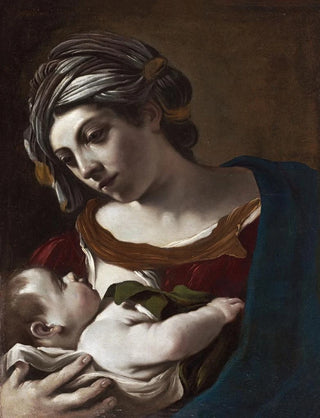Art print | Virgin and Child - Guercino


View from behind

Frame (optional)
Vierge à l'Enfant - Guercino – Engaging Introduction
The "Vierge à l'Enfant" by Guercino is an iconic artwork that embodies the spiritual depth and delicacy of Italian Baroque. Painted in the 17th century, this masterful piece evokes not only maternal tenderness but also a visual dialogue between the divine and the human. Contemplating it, the viewer is immediately transported into a universe where light and shadow meet to create an atmosphere that is both serene and emotional. The artist, known for his mastery of light, manages to capture a moment of grace and intimacy, making this work timeless and universal.
Style and uniqueness of the work
Guercino's style is distinguished by his bold use of chiaroscuro, a technique that highlights the expressions and gestures of the characters while creating a striking contrast with the shadows. In the "Vierge à l'Enfant," soft faces and flowing drapery demonstrate a finesse of detail that draws the eye and invites admiration. The composition is carefully orchestrated, with each element arranged to guide the viewer's gaze toward the center of the work, where the Virgin and the Child meet in a protective embrace. The color palette, dominated by warm and soothing tones, reinforces this impression of warmth and maternal love, thus creating a strong emotional connection with the observer.
The artist and his influence
Guercino, whose real name is Giovanni Francesco Barbieri, is a prominent figure of the Baroque, whose influence extends well beyond his period. Originating from Bologna, he successfully combined the traditions of the Bolognese school with the stylistic innovations of his contemporaries. His unique approach to painting, blending realism and spirituality, paved the way for many artists who followed him. By integrating narrative elements into his works, Guercino was able to touch the hearts of viewers, allowing them to feel the intensity of human emotions. His ability to capture moments of grace and beauty has left an indelible mark on art history, making of

Matte finish

View from behind

Frame (optional)
Vierge à l'Enfant - Guercino – Engaging Introduction
The "Vierge à l'Enfant" by Guercino is an iconic artwork that embodies the spiritual depth and delicacy of Italian Baroque. Painted in the 17th century, this masterful piece evokes not only maternal tenderness but also a visual dialogue between the divine and the human. Contemplating it, the viewer is immediately transported into a universe where light and shadow meet to create an atmosphere that is both serene and emotional. The artist, known for his mastery of light, manages to capture a moment of grace and intimacy, making this work timeless and universal.
Style and uniqueness of the work
Guercino's style is distinguished by his bold use of chiaroscuro, a technique that highlights the expressions and gestures of the characters while creating a striking contrast with the shadows. In the "Vierge à l'Enfant," soft faces and flowing drapery demonstrate a finesse of detail that draws the eye and invites admiration. The composition is carefully orchestrated, with each element arranged to guide the viewer's gaze toward the center of the work, where the Virgin and the Child meet in a protective embrace. The color palette, dominated by warm and soothing tones, reinforces this impression of warmth and maternal love, thus creating a strong emotional connection with the observer.
The artist and his influence
Guercino, whose real name is Giovanni Francesco Barbieri, is a prominent figure of the Baroque, whose influence extends well beyond his period. Originating from Bologna, he successfully combined the traditions of the Bolognese school with the stylistic innovations of his contemporaries. His unique approach to painting, blending realism and spirituality, paved the way for many artists who followed him. By integrating narrative elements into his works, Guercino was able to touch the hearts of viewers, allowing them to feel the intensity of human emotions. His ability to capture moments of grace and beauty has left an indelible mark on art history, making of






